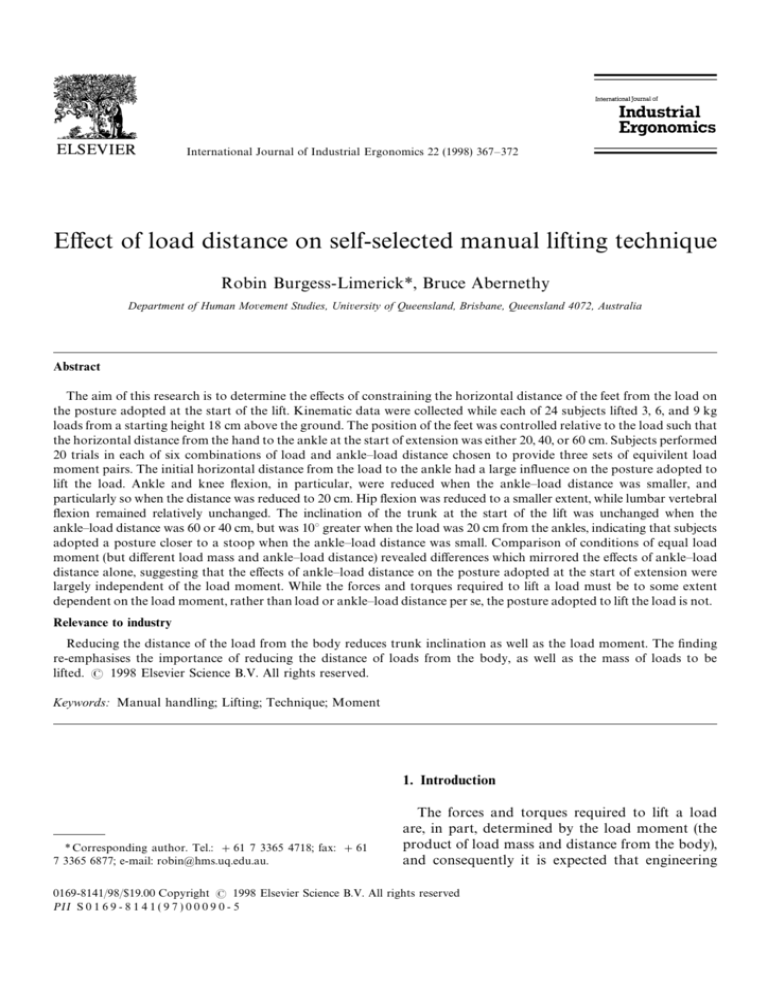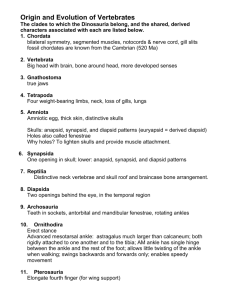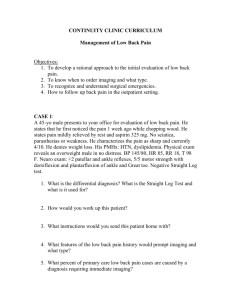
International Journal of Industrial Ergonomics 22 (1998) 367—372
Effect of load distance on self-selected manual lifting technique
Robin Burgess-Limerick*, Bruce Abernethy
Department of Human Movement Studies, University of Queensland, Brisbane, Queensland 4072, Australia
Abstract
The aim of this research is to determine the effects of constraining the horizontal distance of the feet from the load on
the posture adopted at the start of the lift. Kinematic data were collected while each of 24 subjects lifted 3, 6, and 9 kg
loads from a starting height 18 cm above the ground. The position of the feet was controlled relative to the load such that
the horizontal distance from the hand to the ankle at the start of extension was either 20, 40, or 60 cm. Subjects performed
20 trials in each of six combinations of load and ankle—load distance chosen to provide three sets of equivilent load
moment pairs. The initial horizontal distance from the load to the ankle had a large influence on the posture adopted to
lift the load. Ankle and knee flexion, in particular, were reduced when the ankle—load distance was smaller, and
particularly so when the distance was reduced to 20 cm. Hip flexion was reduced to a smaller extent, while lumbar vertebral
flexion remained relatively unchanged. The inclination of the trunk at the start of the lift was unchanged when the
ankle—load distance was 60 or 40 cm, but was 10° greater when the load was 20 cm from the ankles, indicating that subjects
adopted a posture closer to a stoop when the ankle—load distance was small. Comparison of conditions of equal load
moment (but different load mass and ankle—load distance) revealed differences which mirrored the effects of ankle—load
distance alone, suggesting that the effects of ankle—load distance on the posture adopted at the start of extension were
largely independent of the load moment. While the forces and torques required to lift a load must be to some extent
dependent on the load moment, rather than load or ankle—load distance per se, the posture adopted to lift the load is not.
Relevance to industry
Reducing the distance of the load from the body reduces trunk inclination as well as the load moment. The finding
re-emphasises the importance of reducing the distance of loads from the body, as well as the mass of loads to be
lifted. ! 1998 Elsevier Science B.V. All rights reserved.
Keywords: Manual handling; Lifting; Technique; Moment
1. Introduction
* Corresponding author. Tel.: #61 7 3365 4718; fax: #61
7 3365 6877; e-mail: robin@hms.uq.edu.au.
The forces and torques required to lift a load
are, in part, determined by the load moment (the
product of load mass and distance from the body),
and consequently it is expected that engineering
0169-8141/98/$19.00 Copyright ! 1998 Elsevier Science B.V. All rights reserved
PII S 0 1 6 9 - 8 1 4 1 ( 9 7 ) 0 0 0 9 0 - 5
368
R. Burgess-Limerick, B. Abernethy / International Journal of Industrial Ergonomics 22 (1998) 367—372
controls which reduce load moment will reduce the
potential for injury. The question of whether subjects alter the posture adopted to lift loads in
response to changes in load moment is thus of
interest. The effects of changes in load mass on the
posture adopted at the start of lifting has been
described previously (Burgess-Limerick et al.,
1995). When subjects were asked to lift loads using
a self-selected technique the average overall effect of
increases in load mass from 2.5 to 10.5 kg (distance
remaining constant, and hence load moment increasing with mass) was to slightly increase the
flexion of the knee, hip, and lumbar vertebral joints
at the start of the lift.
In this previous experiment, the placement of the
subjects’ feet relative to the load to be lifted was
uncontrolled, simulating the common situation encountered in an occupational setting in which the
lifter has more or less freedom to self-select the
placement of the feet. (The ankle—load distances
chosen ranged from 240 to 400 cm [mean"320 cm]
and were uncorrelated with load mass.) However, in
some occupational situations the task characteristics,
such as size or nature of the load, or structure of the
environment, restrict the placement of the lifter’s feet
relative to the load. Bulky loads, e.g., may increase
the minimum horizontal distance possible between
hands and feet at the start of the lift. Conversely, if
a load was elevated, such that the lifter could place
their feet under the load, then adoption of a position very close to the load would be possible.
In addition to changing the load moment,
changes in the ankle—load distance also have a geometric influence on the joint configurations which
can be adopted to grasp the load. The aim of the
research reported here is to examine the effect of
manipulating the placement of the feet relative to
the load on the posture adopted at the start of the
lift, and to deconfound the geometric influence of
horizontal load distance from the effect due to load
moment by examining conditions of equal load
moment but different ankle—load distance.
2. Methods
Angular motion in the sagittal plane of ankle,
knee, hip, and lumbar vertebral joints was esti-
mated from two-dimensional video images while
each of 24 untrained subjects (11 female and 13
male) performed 120 symmetric bimanual lifts.
Each trial involved flexing from a normal standing
position to lift one of three loads (3, 6 or 9 kg) from
a starting height of 18 cm. The position of the feet
was controlled relative to the load such that the
horizontal distance from the hand to the ankle at
the start of extension was either 20, 40 or 60 cm.
The load mass and foot position variables were
manipulated to form six conditions in which load
moment (mass x distance) was either 120, 180 or
360 kg cm. The six conditions were: (i) 3 kg, 40 cm;
(ii) 3 kg, 60 cm; (iii) 6 kg, 60 cm; (iv) 6 kg, 20 cm; (v)
9 kg, 20 cm; (vi) 9 kg, 40 cm. The trials were performed in blocks of five trials in each condition, and
this 30 trial series was performed four times.
Subjects were given a brief standardised explanation of the purpose of the experiment. The standardised instructions given to the subjects emphasised
that they were to lift the load in “the way you
would normally do the task, i.e., the most comfortable way for you”. The subjects were instructed to
adopt a normal standing posture facing the load,
with feet approximately parallel and an equal distance from the load.
Ten spherical reflective markers (30 mm diameter) were placed on the right side of each subject
on the following anatomical locations: (i) head of
the fifth metatarsal; (ii) lateral malleolus; (iii) lateral
surface of the shank on a line joining the lateral
malleolus to the knee joint centre; (iv) lateral surface of the thigh on a line joining the knee joint
centre with the greater trochanter; (v) superior
point of the greater trochanter; (vi) posterior superior iliac spine; (vii) anterior superior iliac spine;
(viii) spinous process of the first thoracic vertebra;
(ix) head of the radius; and (x) dorsal surface of the
hand.
These markers defined lumbar vertebral, hip,
knee, and ankle angles (Fig. 1). All were defined as
included angles which increased when the joint
extended or, in the case of the ankle, plantar-flexed.
Lumbar vertebral angle was defined as the anterior
angle subtended by lines joining the first thoracic
vertebra, posterior superior iliac spine, and anterior
superior iliac spine markers. Hip angle was defined
as the anterior angle subtended between the line
R. Burgess-Limerick, B. Abernethy / International Journal of Industrial Ergonomics 22 (1998) 367—372
369
9 kg, 40 cm) were compared to deconfound the
geometric influence of horizontal load distance
from the effect due to load moment. A bonferroni
correction was employed in that a critical probability of 0.001 was adopted to restrict the overall type
one error rate to less than 0.05. The coefficient of
determination (r!) was calculated as a measure of
effect size.
3. Results and discussion
Fig. 1. Definition of joint angles.
joining posterior superior iliac spine and anterior
superior iliac spine and the extrapolated line of the
femur (as defined by thigh and greater trochanter
markers). This angle became negative in extreme
hip flexion. Knee angle was defined as the posterior
angle subtended by the extrapolated line of the
femur and the extrapolated line of the shank (as
defined by shank and ankle markers). The ankle
angle was defined as the anterior angle subtended
by the shank, ankle, and foot markers.
The start of each lift was defined as the time at
which the hand marker reached minimum in its
vertical displacement. The range of flexion from
normal standing at each joint at this time was
determined. Subject mean dependent variables for
each condition were calculated from the last 15
trials performed in each condition (i.e., trials
31—120). These mean values were submitted to nine
planned comparisons for each dependent variable.
The effect of load mass was examined by comparing three pairs of constant distance conditions
(3 kg, 60 cm and 6 kg, 60 cm; 6 kg, 20 cm and 9 kg,
20 cm; 3 kg, 40 cm and 9 kg, 40 cm), the effect of
starting height was assessed by comparing three
pairs of constant load mass conditions (9 kg, 20 cm
and 9 kg, 40 cm; 3 kg, 40 cm and 3 kg, 60 cm; 6 kg,
20 cm and 6 kg, 60 cm), and three pairs of constant
load moment conditions (3 kg, 40 cm and 6 kg,
20 cm; 3 kg, 60 cm and 9 kg, 20 cm; 6 kg, 60 cm and
Load mass had a small and inconsistent effect on
ankle position at the start of extension (r!(0.03),
however, the manipulation of ankle—load distance
had a much larger effect (Fig. 2). Increases in the
ankle—load distance were associated with large increases in the flexion of the ankle from normal
standing at the start of extension, particularly when
the distance increased from 20 to 40 cm (r!"0.70,
p(0.001). These differences remained when comparisons of constant moment conditions were
made, suggesting that the effect of ankle—load distance is independent of changes in load moment.
The tight coupling between ankle and knee is
reflected in the similarity of the results obtained for
these joints (Fig. 3). When the ankle—load distance
Fig. 2. Ankle position at the start of extension as a function of
ankle—load distance and load mass. Lines join conditions of
equal load moment.
370
R. Burgess-Limerick, B. Abernethy / International Journal of Industrial Ergonomics 22 (1998) 367—372
Fig. 3. Knee position at the start of extension as a function of
ankle—load distance and load mass.
Fig. 4. Hip position at the start of extension as a function of
ankle—load distance and load mass.
was 40 or 60 cm the effect of increased load was to
increase flexion of the knee at the start of extension,
while the effect was reversed when the ankle—load
distance was 20 cm. Again, however, load mass
accounts for only a very small proportion of the
variance in knee positions (r!(0.02). Changes in
ankle—load distance, and especially a change from
20 to 40 cm, had a much larger effect on the posture
adopted at the start of extension (r!"0.62,
p(0.001). In each case, an increase in ankle—load
distance was associated with increased flexion of
the knee at the start of extension, and comparison
of constant moment conditions revealed that the
effect of ankle—load distance was independent of
load moment per se.
In contrast to the ankle and knee, the effect of
load mass on the position of the hip at the start of
extension was consistent across ankle—load distance conditions (Fig. 4). In all cases, increases in
load mass while ankle—load distance remained constant were associated with increases in the flexion
of the hip at the start of extension, although the
proportion of the variance accounted for was small
(r!(0.04). Increases in ankle—load distance while
load mass remained constant were similarly associated with increases in hip flexion (r!"0.13).
Comparison of conditions of equal load moment
suggests that the effect of increasing ankle—load
distance from 20—40 cm on hip flexion is a consequence of the increased load moment, while an
additional effect was evident when the distance
increased from 40 to 60 cm.
Lumbar vertebral flexion at the start of extension
was generally increased by increases in load mass
while ankle—load distance remains constant, although the effect was only significant (p(0.001)
when the ankle—load distance was 60 cm (Fig. 5).
Reduction of the ankle—load distance below 40 cm
did not have a reliable effect on lumbar vertebral
position at the start of extension, however increasing the ankle—load distance from 40 to 60 cm
caused lumbar vertebral flexion to be increased
slightly (r!"0.02, p(0.001). Comparison of the
40 and 60 cm distance conditions in which load
moment remained constant suggests that the effect
of this change in ankle—load distance on lumbar
vertebral position at the start of extension was
independent of load moment.
Changes in load mass did not cause changes in
trunk inclination at the start of extension when the
ankle—load distance was 40 or 60 cm, but increasing the load from 6 to 9 kg when the ankle—load
distance was 20 cm caused a small but reliable
increase in trunk inclination (p(0.001; Fig. 6).
R. Burgess-Limerick, B. Abernethy / International Journal of Industrial Ergonomics 22 (1998) 367—372
Fig. 5. Lumbar vertebral position at the start of extension as
a function of ankle—load distance and load mass.
371
son of trunk inclination at these distances in conditions of constant moment reveals that the effect
of ankle—load distance is independent of load
moment.
The effect of ankle—load distance on trunk inclination reflects a consistent tendency, when the
ankle—load distance was 20 cm, for subjects to
adopt a posture at the start of extension in which
the knee joints were less flexed relative to the
flexion of the hip and lumbar vertebral joints.
A consequence is that the inclination of the trunk
forward from the vertical was increased on average
by 10° in these conditions regardless of the load
mass lifted from this location.
Lifting from such a relatively stooped posture
reduces the vertical distance through which the
body centre of gravity is moved, and thus reduces
the mechanical work required. It might be suggested that when the load moment becomes relatively small, minimum work criteria become
more important in reducing muscular energy expenditure than optimising joint coordination.
However, the current results show clearly that
load moment has less influence than the position of
the load relative to the body, although this influence is not determinsitic, in that a posture with
flexed knees can be adopted to lift a load very close
to the body.
4. Conclusions
Fig. 6. Trunk inclination at the start of extension as a function
of ankle—load distance and load mass.
Similarly, changes in ankle—load distance between
40 and 60 cm were not associated with changes in
trunk inclination, while increasing ankle—load distance from 20 to 40 cm was associated with a increase in trunk inclination at the start of extension
of the order of 10° (r!"0.27, p(0.001). Compari-
In general, the effects of load mass on posture
were small (accounting for 3% of the variance or
less), and the directions of these effects was in some
cases dependent on the ankle—load horizontal distance at which the comparison was made. In contrast, the initial horizontal distance from the load
to the ankle had a large influence on the posture
adopted to lift the load. Ankle and knee flexion, in
particular, were reduced when the ankle—load distance was smaller, and particularly when the distance was 20 cm. Hip flexion was reduced to
a smaller extent, while lumbar vertebral flexion
remained relatively unchanged. The inclination of
the trunk at the start of the lift was unchanged
when the ankle—load distance was decreased from
60 to 40 cm, but increased by 10° when the load was
372
R. Burgess-Limerick, B. Abernethy / International Journal of Industrial Ergonomics 22 (1998) 367—372
moved to 20 cm from the ankles, indicating that
subjects adopted a posture closer to a stoop when
the ankle—load distance was small.
Comparison of conditions of equal load moment
(but different load mass and ankle—load distance)
revealed differences which mirrored the effects
of ankle—load distance alone, suggesting that
the effects of ankle—load distance on the posture
adopted at the start of extension were independent of the load moment. While the forces and
torques required to lift a load must be largely
dependent on the load moment, rather than load
or ankle—load distance, the posture adopted to lift
the load is not.
Acknowledgements
The research reported here was financially
supported by a grant from WORKSAFE
AUSTRALIA to the authors, Dr. Robert Neal, and
Dr. Vaughan Kippers. We thank Myles Cavill for
help with the data collection and video digitising.
References
Burgess-Limerick, R., Abernethy, B., Neal, R.J., Kippers, V.,
1995. Self-selected manual lifting technique: Functional consequences of interjoint coordination. Human Factors 37,
395—411.








